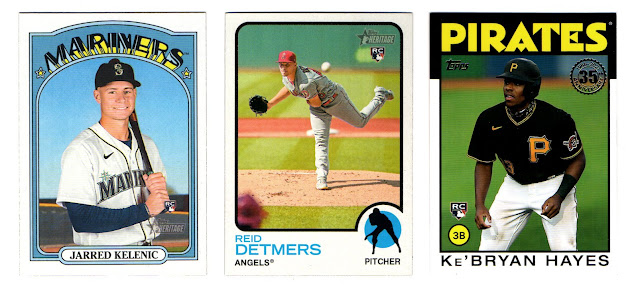Imagine this:
You and your brother Phil are growing up in Sault Ste. Marie, Ontairo, in the 1950s.
Phil is developing into quite a hockey player. You're not so bad
yourself, but don't have the shooting and scoring touch that Phil does.
The rule when you shoot pucks for practice with him and some neighborhood friends? Whoever
scores the fewest goals against the current kid playing goalie would have to be goalie next. And guess who would often end up being the goalie?
You.
But it helped you hone your skills. Phil, too. Fast-forward about a decade, to the 1963-64 season, and your older brother would be suiting up for his first NHL game. Around the same time, you'd be in goal and leading your NCAA Michigan Tech Huskies to the NCAA Championship. Just a couple of years later you'd be off to the Western Hockey League for your first professional experience, and in 1967, the Montreal Canadiens came calling, offering you a contract as a free agent.
Well, by this point older brother Phil had just been traded from the Chicago Black Hawks to the Boston Bruins, and he was really starting to light it up. During the 1968-69 season, his second with the Bruins, Phil put up 49 goals, 77 assists, and 126 points—all career highs to that point. He was named to the all-star team, and would take home the Hart trophy (most valuable player) and Art Ross trophy (top point scorer) at year's end.
Meanwhile, in Montreal, you were sitting behind Rogie Vachon and Gump Worsley on the goaltending chart. Tough to find some playing time there. You'd get into an occasional game for replacement duty, but that was it.
Then, as November turned to December, both Vachon and Worsley found themselves banged up. And on December 5th, you'd get your first NHL start.
Guess who you'd be facing?
Yep, the Boston Bruins. And your brother Phil. In Boston Garden.
Talk about going from the frying pan into the fire.
But it was an excellent game. The Bruins peppered you with 35 shots, and you stopped all but two of them. Your team put in two goals of their own, and the game ended in a 2–2 tie.
Guess who scored both goals against you?
Yep, your brother Phil.
Mom was so mad at him.
You'd get a handful of starts over the remainder of the season, and that summer you'd be claimed by Phil's former team, the Black Hawks. That's where you really took off. In the 1969-70 season you'd play 63 games, chalk up 38 wins against just 17 losses, and post a 2.17 goals-against average and .932 save percentage. And here's the most remarkable number:
Of those 38 wins, 15 of them were shutouts. Fifteen! You'd be an all-star for the first time, and would win the Calder trophy (rookie of the year) and the Vezina trophy (best goaltender) at year's end. You almost took the Hart trophy as well, but finished second to Bobby Orr.
Here are the brothers just a couple of seasons later, when they were both household names across the North American continent.
 |
1971-72 Topps #20 Phil Esposito and #110 Tony Esposito
|
For their exploits over the previous few seasons, both Tony and Phil were chosen to represent Team Canada in the
1972 Summit Series against the Soviet Union. Tony finished the series with
the lowest goals-against average (3.25) of all goalies—and that means Canadian counterpart Ken Dryden and Soviet star Vladislav Tretiak.
Brother Phil put up great
numbers himself, leading the team in goals (7), assists (6), and points
(13) across the 8 games.
How about that for two brothers?
Normally at this point we'd compare stats for both of them in a table. However, this time we've got a forward and a goalie, so we'll do one table for Phil, and a separate table for Tony.
PHIL ESPOSITO (career
highs in bold)
|
|
CAREER
(18 seasons)
|
BEST SEASON
(1970-71, Boston)
|
|
GAMES PLAYED
|
1282
|
78
|
|
GOALS
|
717
|
76
|
|
ASSISTS
|
873
|
76
|
|
POINTS
|
1590
|
152
|
|
PENALTY
MINUTES
|
910
|
71
|
|
GAME-WINNING
GOALS
|
118
|
16
|
TONY ESPOSITO (career
highs in bold)
|
|
CAREER
(16 seasons)
|
BEST SEASON
(1969-70, Chicago)
|
|
GAMES PLAYED
|
886
|
63
|
|
WINS
|
423
|
38
|
|
LOSSES
|
306
|
17
|
|
TIES
|
152
|
8
|
|
SHUTOUTS
|
76
|
15
|
|
GOALS-AGAINST
AVERAGE
|
2.93
|
2.17
|
|
SAVE
PERCENTAGE
|
.906
|
.932
|
Phil is a member of the Hockey Hall of Fame (1984), a 2x Cup winner, 8x All Star, 5x Art Ross trophy winner, 2x Hart trophy winner, and 2x Pearson trophy winner. He played for the Black Hawks, Bruins, and Rangers.
He had quite a 1969-70 playoff run to the Stanley Cup championship, leading the league in goals (13), assists (14), points (27), even-strength goals (9), and power-play goals (4). Here are his career playoff numbers, which are quite impressive: 130 GP, 61 G, 76 A, 137 PTS, 138 PIM, 22 PPG, 11 GWG
Tony is also a member of the Hockey Hall of Fame (1988). He was a Calder trophy winner, 5x All Star, and 3x Vezina trophy winner. Another noteworthy stat: Tony led the league in total shots against AND total saves five times in a seven-year span! (From 1974-75 to 1980-81)
That's a lot of pucks to have fired in your direction.
Aside from that first season with Montreal, he played his entire career with the Black Hawks. He was also an early pioneer of the butterfly style of goaltending, which is still being used in various forms today.
So here's to the Esposito brothers. Two absolutely astonishing careers, and a great brother vs. brother memory back in 1968.













